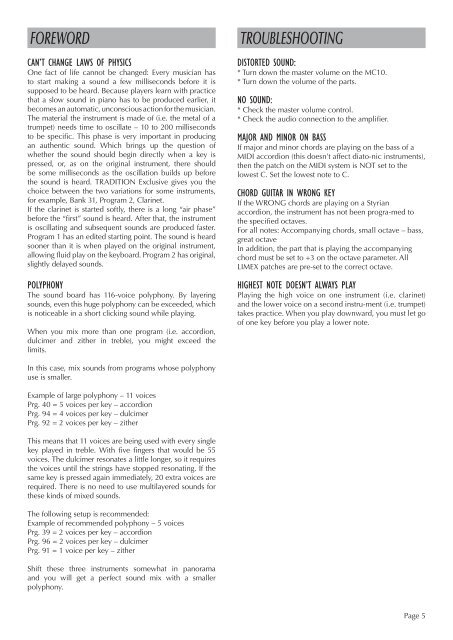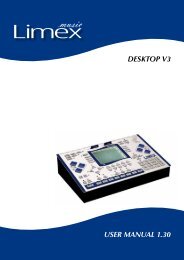doppelpack - limex
doppelpack - limex
doppelpack - limex
Create successful ePaper yourself
Turn your PDF publications into a flip-book with our unique Google optimized e-Paper software.
FOREWORD<br />
CAN’T CHANGE LAWS OF PHYSICS<br />
One fact of life cannot be changed: Every musician has<br />
to start making a sound a few milliseconds before it is<br />
supposed to be heard. Because players learn with practice<br />
that a slow sound in piano has to be produced earlier, it<br />
becomes an automatic, unconscious action for the musician.<br />
The material the instrument is made of (i.e. the metal of a<br />
trumpet) needs time to oscillate – 10 to 200 milliseconds<br />
to be specific. This phase is very important in producing<br />
an authentic sound. Which brings up the question of<br />
whether the sound should begin directly when a key is<br />
pressed, or, as on the original instrument, there should<br />
be some milliseconds as the oscillation builds up before<br />
the sound is heard. TRADITION Exclusive gives you the<br />
choice between the two variations for some instruments,<br />
for example, Bank 31, Program 2, Clarinet.<br />
If the clarinet is started softly, there is a long “air phase”<br />
before the “first” sound is heard. After that, the instrument<br />
is oscillating and subsequent sounds are produced faster.<br />
Program 1 has an edited starting point. The sound is heard<br />
sooner than it is when played on the original instrument,<br />
allowing fluid play on the keyboard. Program 2 has original,<br />
slightly delayed sounds.<br />
POLYPHONY<br />
The sound board has 116-voice polyphony. By layering<br />
sounds, even this huge polyphony can be exceeded, which<br />
is noticeable in a short clicking sound while playing.<br />
When you mix more than one program (i.e. accordion,<br />
dulcimer and zither in treble), you might exceed the<br />
limits.<br />
In this case, mix sounds from programs whose polyphony<br />
use is smaller.<br />
Example of large polyphony – 11 voices<br />
Prg. 40 = 5 voices per key – accordion<br />
Prg. 94 = 4 voices per key – dulcimer<br />
Prg. 92 = 2 voices per key – zither<br />
This means that 11 voices are being used with every single<br />
key played in treble. With five fingers that would be 55<br />
voices. The dulcimer resonates a little longer, so it requires<br />
the voices until the strings have stopped resonating. If the<br />
same key is pressed again immediately, 20 extra voices are<br />
required. There is no need to use multilayered sounds for<br />
these kinds of mixed sounds.<br />
The following setup is recommended:<br />
Example of recommended polyphony – 5 voices<br />
Prg. 39 = 2 voices per key – accordion<br />
Prg. 96 = 2 voices per key – dulcimer<br />
Prg. 91 = 1 voice per key – zither<br />
Shift these three instruments somewhat in panorama<br />
and you will get a perfect sound mix with a smaller<br />
polyphony.<br />
TROUBLESHOOTING<br />
DISTORTED SOUND:<br />
* Turn down the master volume on the MC10.<br />
* Turn down the volume of the parts.<br />
NO SOUND:<br />
* Check the master volume control.<br />
* Check the audio connection to the amplifier.<br />
MAJOR AND MINOR ON BASS<br />
If major and minor chords are playing on the bass of a<br />
MIDI accordion (this doesn’t affect diato-nic instruments),<br />
then the patch on the MIDI system is NOT set to the<br />
lowest C. Set the lowest note to C.<br />
CHORD GUITAR IN WRONG KEY<br />
If the WRONG chords are playing on a Styrian<br />
accordion, the instrument has not been progra-med to<br />
the specified octaves.<br />
For all notes: Accompanying chords, small octave – bass,<br />
great octave<br />
In addition, the part that is playing the accompanying<br />
chord must be set to +3 on the octave parameter. All<br />
LIMEX patches are pre-set to the correct octave.<br />
HIGHEST NOTE DOESN’T ALWAYS PLAY<br />
Playing the high voice on one instrument (i.e. clarinet)<br />
and the lower voice on a second instru-ment (i.e. trumpet)<br />
takes practice. When you play downward, you must let go<br />
of one key before you play a lower note.<br />
Page 5




